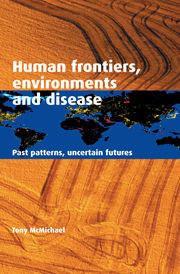Book contents
- Frontmatter
- Contents
- List of sources for illustrations
- Preface
- 1 Disease patterns in human biohistory
- 2 Human biology: the Pleistocene inheritance
- 3 Adapting to diversity: climate, food and infection
- 4 Infectious disease: humans and microbes coevolving
- 5 The Third Horseman: food, farming and famines
- 6 The industrial era: the Fifth Horseman?
- 7 Longer lives and lower birth rates
- 8 Modern affluence: lands of milk and honey
- 9 Cities, social environments and synapses
- 10 Global environmental change: overstepping limits
- 11 Health and disease: an ecological perspective
- 12 Footprints to the future: treading less heavily
- Notes
- Index
3 - Adapting to diversity: climate, food and infection
Published online by Cambridge University Press: 05 March 2012
- Frontmatter
- Contents
- List of sources for illustrations
- Preface
- 1 Disease patterns in human biohistory
- 2 Human biology: the Pleistocene inheritance
- 3 Adapting to diversity: climate, food and infection
- 4 Infectious disease: humans and microbes coevolving
- 5 The Third Horseman: food, farming and famines
- 6 The industrial era: the Fifth Horseman?
- 7 Longer lives and lower birth rates
- 8 Modern affluence: lands of milk and honey
- 9 Cities, social environments and synapses
- 10 Global environmental change: overstepping limits
- 11 Health and disease: an ecological perspective
- 12 Footprints to the future: treading less heavily
- Notes
- Index
Summary
It is approximately one hundred years since scientists first understood the basic currency of heredity: the discrete, non-divisible gene. In the 1860s Gregor Mendel discovered ‘particulate’ inheritance with his studies of garden peas in a monastery in Brno (in today's Czech Republic). However, his published findings were ignored by mainstream science for several decades.
Tantalisingly, Mendel's discovery was the crucial clue that eluded Charles Darwin, whose great work The Origin of Species, had been published in 1859. Darwin could only imagine, unsatisfactorily, that inherited characteristics were somehow transmitted by blood-borne ‘gemules’ that blended parental characteristics. But, over several generations, this blending would dilute the originally selected phenotypic character. Mendel's findings provided the answer. He crossed a wrinkled-pea plant with a smooth-pea plant and found that some offspring plants were wrinkled and some were smooth. There was no blending: each plant was either one thing or the other. Mendel inferred that each such character-specifying ‘gene’ comprised alternate all-or-nothing versions that were the irreducible units of inheritance. These alternate versions we recognise today as alleles.
We each carry a unique combination of genetic alleles and a few newly arising non-lethal mutations. Indeed, each of us is one of nature's little experiments, on stand-by for testing against the possibility of unexpected environmental change. Some genes influence susceptibility to particular disease processes. Susceptibility, however, is not predestination; the health outcome usually depends on interactions between genes and environment.
- Type
- Chapter
- Information
- Human Frontiers, Environments and DiseasePast Patterns, Uncertain Futures, pp. 58 - 87Publisher: Cambridge University PressPrint publication year: 2001



